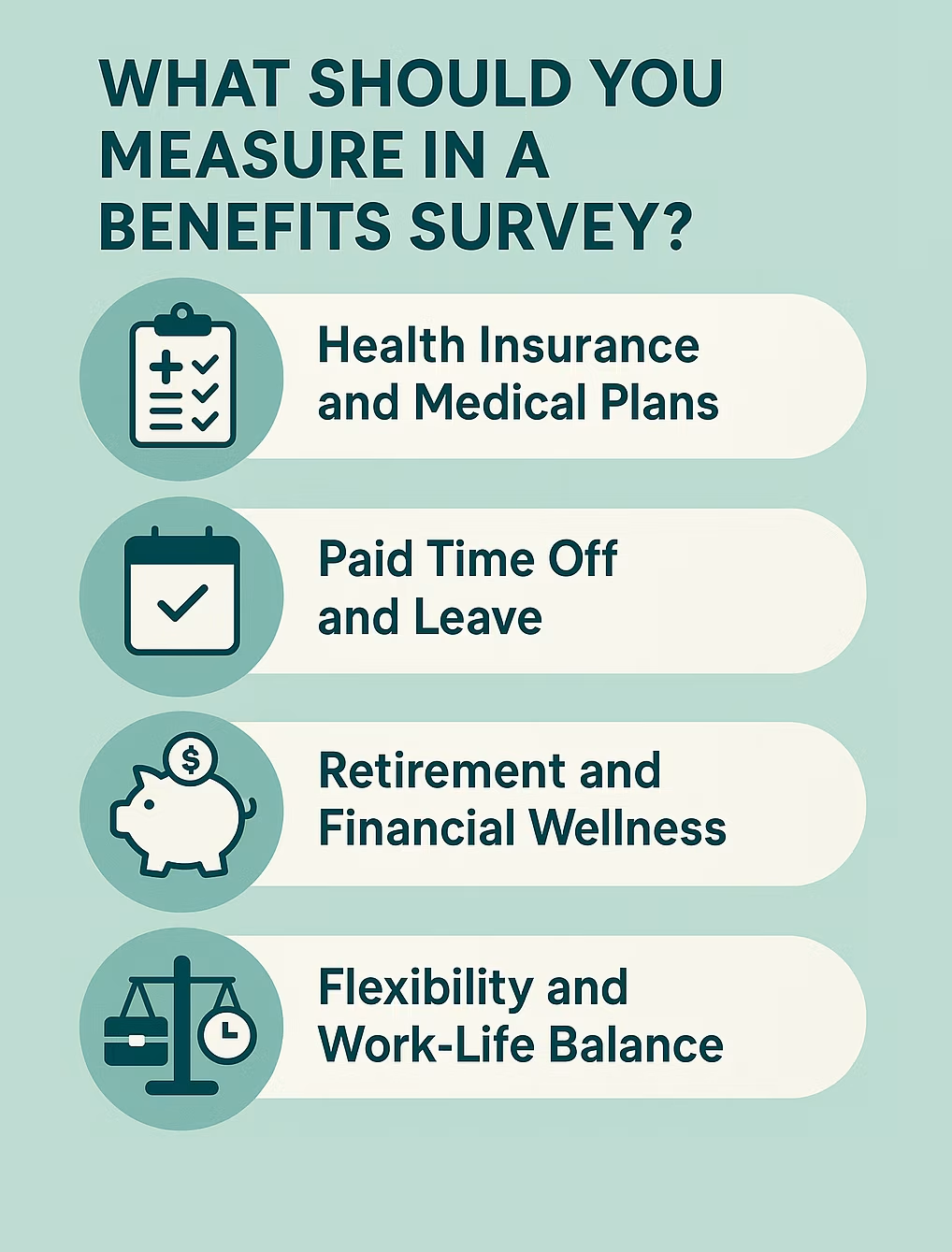Employee Benefits Survey: Build a Program Employees Truly Value
Employee benefits surveys tell us something employers often miss: people don’t just want more perks—they want the right ones.
In fact, 48% of job seekers say benefits are a key deciding factor when choosing their next role (Gallagher, 2022). And among current employees, 60% say their benefits package is a big reason they stay with their company (Aflac, 2023).
So, how well do your benefits align with what your employees actually want?
An employee benefits survey is one of the most effective tools for closing that gap. This guide walks you through why benefits surveys matter, what to measure, and how to act on what you learn—so you can shape a benefits package that improves satisfaction, boosts loyalty, and drives retention.
Why Conduct an Employee Benefits Survey?
The job market in 2025 is fast-moving and highly personalized. Employees today expect more than a standard set of health and retirement benefits—they want flexibility, well-being support, and perks that match their lifestyles.
Here’s why a benefits survey helps you meet those expectations:
1. Avoid Wasted Benefits
Every year, billions of dollars in benefits go unused. Employees may not understand their options, feel uncomfortable accessing them, or simply find them irrelevant.
Example: Paid Time Off. In 2022, U.S. employees left an average of 5.6 vacation days unused (U.S. Travel Association)—which adds up to huge liabilities for companies and unclaimed value for workers.
A well-crafted survey uncovers which benefits employees aren’t using and why—so you can make strategic improvements that increase adoption and ROI.
2. Create a Culture of Listening
Benefits are personal. By asking employees directly about their needs, you signal that their voices matter—especially when you follow through.
This trust-building effect is just as important as the feedback itself. When people feel heard, they’re more likely to stick around. As one Gallup study shows, companies that prioritize feedback see up to 14.9% lower turnover rates (Gallup, 2023).
3. Adapt to Changing Workforce Needs
As Millennials and Gen Z take over the workforce, their expectations differ from previous generations. They value flexibility, mental health support, purpose-driven work, and the ability to personalize benefits.
Yet only 36% of employees say they have any input in what benefits they receive (SHRM, 2024).
A survey helps you proactively track these shifts and ensure your offerings stay relevant—rather than reactive.

What Should You Measure in a Benefits Survey?
Let your survey cover all key categories of your benefits program. But don’t just look at satisfaction—ask questions that reveal clarity, usage, importance, and potential barriers.
Here’s a breakdown of what to measure:
Health Insurance and Medical Plans
Health benefits are the cornerstone of most packages, and for good reason. Medical coverage is often the most complex—and most valued—benefit an employer can offer.
Ask about:
- Satisfaction with coverage options
- Affordability of premiums and co-pays
- Clarity around what’s included
- Access to mental health services
Even if you offer great health benefits on paper, employees may not understand or feel confident using them. A survey helps you spot and fix that gap.
Paid Time Off and Leave
Many employees don’t feel fully empowered to take time off, even when they have it. The culture around PTO matters as much as the policy itself.
Use your survey to explore:
- Comfort in requesting time off
- Satisfaction with PTO allotment
- Understanding of sick, bereavement, or parental leave policies
This feedback shows whether your time-off policies are actually supporting well-being—or silently contributing to burnout.
Retirement and Financial Wellness
After health coverage, retirement is often the most important long-term benefit. But it can be confusing for employees to navigate.
Ask about:
- Confidence in retirement readiness
- Clarity around company contributions
- Availability and usefulness of financial planning resources
You can also include questions about debt support, savings tools, or education reimbursements if they’re part of your offering.
Flexibility and Work-Life Balance
Flexibility has gone from perk to expectation. Employees want more control over where, when, and how they work.
Use your survey to assess:
- Access to remote or hybrid options
- Satisfaction with work-life balance
- Feelings of always being “on” due to digital tools
These questions can uncover signs of stress, overload, or burnout—helping you intervene early.

Sample Employee Benefits Survey Questions
A well-balanced survey includes multiple question types—ratings, multiple choice, and open-ended—to capture both data and context.
Here are 15 sample questions to include:
- Which three benefits matter most to you?
- How satisfied are you with the health insurance coverage provided?
- Are your healthcare costs (premiums, deductibles, etc.) affordable?
- How well do you understand your retirement plan options?
- Do you feel our retirement contributions are competitive?
- Are you satisfied with the amount of paid time off you receive?
- Do you feel comfortable using your time off when needed?
- How important is remote or hybrid work flexibility to you?
- On a scale of 1 to 5, how supported do you feel in balancing work and life?
- Do you feel mental health resources are accessible and useful?
- How clear are the steps for requesting parental leave?
- Have you used any wellness programs in the past 6 months?
- Do you feel our benefits reflect the needs of a diverse workforce?
- What changes would improve your experience with our benefits?
- How likely are you to recommend our benefits package to a friend?
Keep the survey short and meaningful—10 to 15 questions is often enough to get strong insights without overwhelming employees.
Best Practices for Running and Analyzing Your Survey
Getting useful responses from a benefits survey comes down to trust, timing, and follow-through. Here’s how to do it well:
Ensure Anonymity
Employees must feel safe being honest. Use a third-party survey tool or disable any identifying info to protect their responses.
Make the distinction between confidential (HR can see who said what) and anonymous (no way to link data back to individuals). The more anonymous, the more honest the feedback.
Communicate the Why
Before you launch the survey, explain why you’re running it and what you’ll do with the results. Sample intro message:
“We’re reviewing our benefits to better support your well-being. This survey will help us understand what’s working, what’s missing, and what you’d value more. It’s 100% anonymous, and we’ll share the findings and next steps with everyone.”
Benchmark Against Industry Standards
After you collect responses, compare your results with external benchmarks. Resources like SHRM’s annual benefits survey or Gallup’s workplace reports offer helpful context.
If your health benefits score 3.8/5 internally, but the industry average is 4.3, you know where to improve.
Act on the Feedback
The worst thing you can do is ask for input… and then go quiet. Instead:
- Share a summary of what you learned
- Highlight changes you’re making as a result
- Set a timeline for reviewing progress
Even small changes like clarifying leave policies or expanding telehealth can go a long way when employees see the connection between their voice and your actions.
Rethink Benefits as a Retention Lever
Attracting and retaining top talent isn’t about offering more—it’s about offering what matters most.
Your employee benefits survey gives you a direct window into what your people truly value. The insights don’t just help you save money on underused perks—they help you design a workplace people want to stay in.
Think of it as a relationship-builder. Instead of guessing, you’re listening. Instead of offering generic perks, you’re designing personalized support systems. And that shift—from transactional to intentional—makes all the difference.
A well-executed benefits strategy tells your team: “We see you. We support you. We want you to stay.”
So start with the survey. Let your employees guide the future of your benefits. And build a workplace where people choose to grow—not just work.



